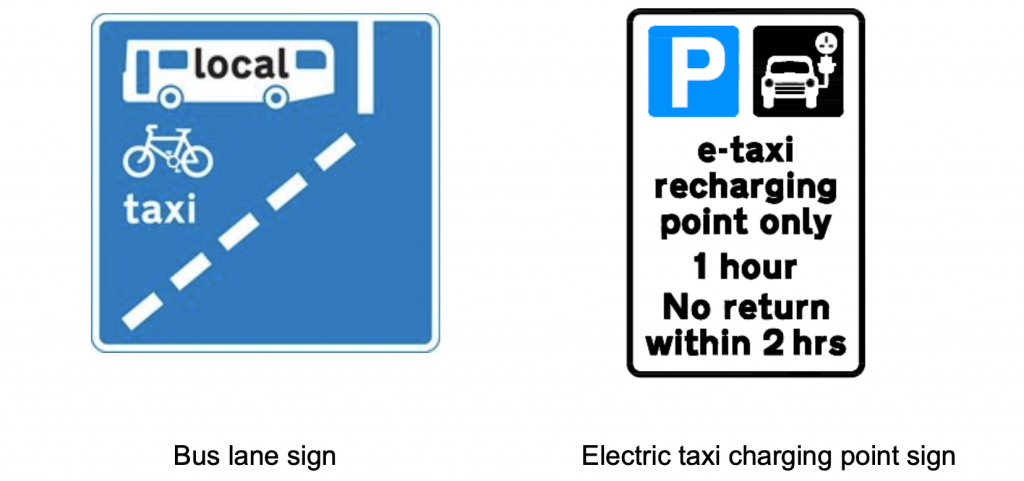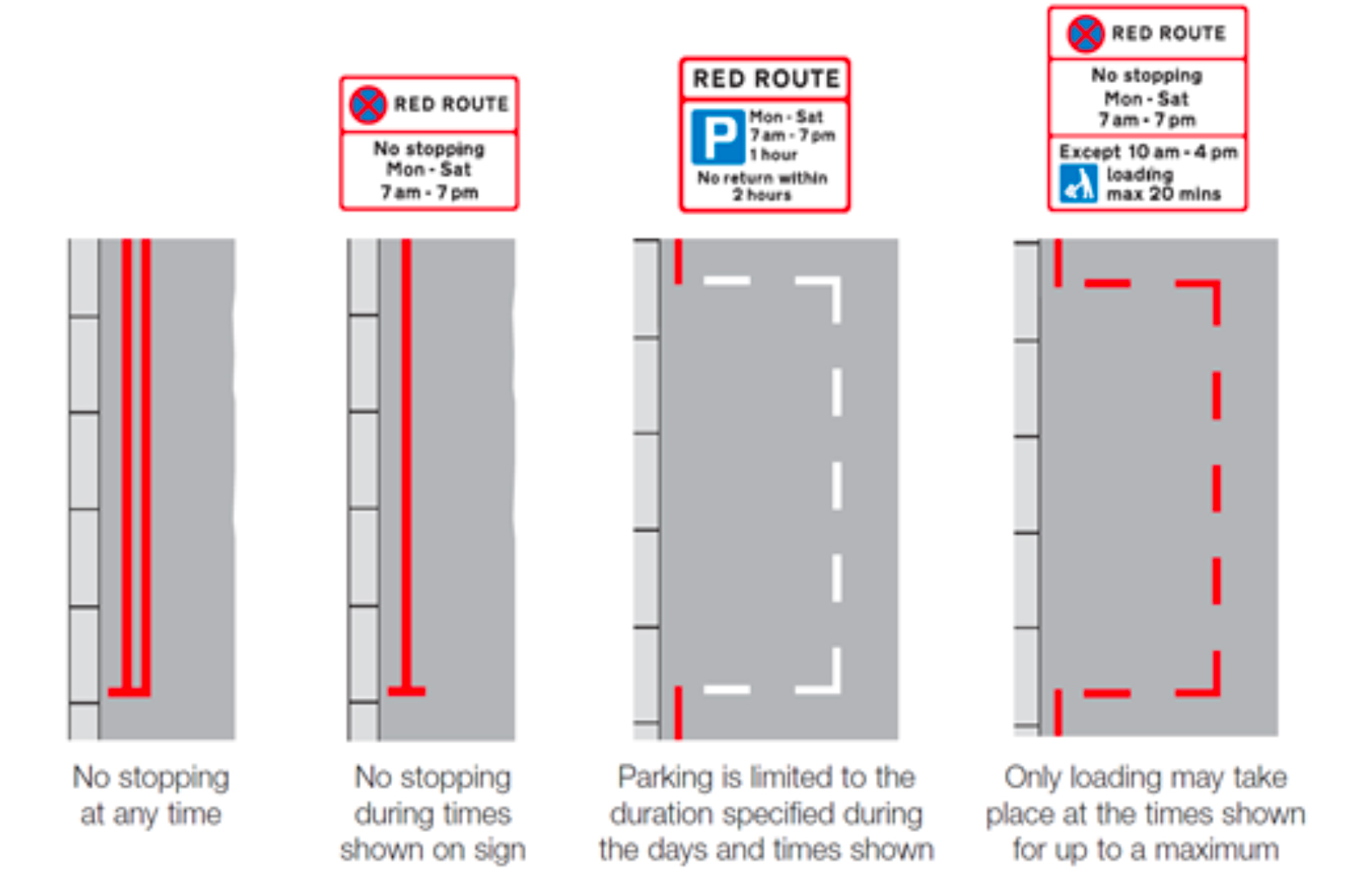This section gives general information on parking and driving in London. It does not replace the need for you to be aware of your responsibilities under The Highway Code.
You must remember that:
• PHVs are not allowed to drive in bus lanes
• PHVs are not allowed to park, wait, drop off or collect passengers on a taxi rank
• PHVs are not allowed to use or park on electric taxi charge points
A PHV is not a taxi. If a road sign shows that access is for a taxi you are not allowed access. Here are two examples:

Stopping and waiting
Private hire drivers can stop to pick up or drop off passengers in many areas where there are rules in place to limit waiting or stopping. You need to remember that:
• PHV drivers should not stop in any place where they might stop other vehicles moving or be a danger to other road users.
• PHV drivers must not stop on zig-zag lines (for example, by pedestrian crossings, outside schools)
You should check what signage is displayed about stopping or waiting and make sure you understand and follow the instructions:
• You can pick up or drop off passengers:
– On single and double red lines
– On single and double yellow lines
– In places where loading is not allowed (shown by markings on the kerb)
– In most parking bays
– In most bus lanes, although you should avoid this if possible as it might delay or obstruct buses
But remember you cannot wait for passengers in these areas.
• You can stop in the above locations only long enough for the passengers to get in or out of your vehicle. This includes the time to help passengers who need assistance, for example wheelchair users, including the time needed to make sure the wheelchair is in the right position and safely secured
• You should not stop on taxi ranks, even when picking up or dropping off passengers
• If there are waiting or parking restrictions, you cannot stop for longer than is needed for the passenger to get in or out of the vehicle. (There is no general permission that allows you to leave your vehicle to help a passenger to or from a building. However, some councils understand and accept that this is an important part of your job. If your passenger needs help, you should spend only a short time away from your vehicle, if possible, and make a note of the passenger’s details/booking, just in case you get a Penalty Charge Notice (PCN). It will be down to the council who issued the PCN to decide whether to accept this evidence and cancel the PCN
• If you are not picking up or dropping off a passenger, you may get a PCN if you wait somewhere where there are restrictions. This can happen even if you have arrived early for a booking or the passenger is late, or if a passenger has asked you to stop and wait while they visit a shop or use a cashpoint
• You should not leave your engine running while you are waiting. If your engine is running while you are parked or waiting you are polluting the environment, and this can be illegal on a public road
• Never drop passengers off in the middle of the road, even if your vehicle is stopped due to traffic. You should always get close to the kerb
Bus lanes and bus stops
You must:
• Enter and leave the bus lane in the most direct and safe way. Pay careful attention to cyclists and motorcyclists who are able to use bus lanes and to pedestrians and bus passengers that may be getting off the bus and crossing the road
• Not stop at ‘bus stop clearways’ marked with a wide yellow line by the kerb. On red routes, you cannot stop at bus stops marked with a wide red line by the kerb. You should try not to stop at other red route bus stops to avoid delaying or obstructing buses
• Remember that only licensed taxis can use bus lanes – PHVs are not allowed to
You should avoid picking up or dropping off passengers at bus stops as this can delay
buses and may not be allowed at some bus stops.
Taxi ranks
If you park or wait on a taxi rank you may be fined and TfL may also take licensing action against you. This could include suspending or revoking your PHV driver’s licence.
Electric taxi charging points
If you park or wait on an electric taxi charging point, or use it to charge a PHV, you may be fined and TfL may also take licensing action against you. This could include suspending or revoking your PHV driver’s licence.
Penalty Charge Notices (PCNs)
You can get a PCN for parking offences or other moving traffic offences such as driving in a bus lane, banned turns or movements (e.g. an illegal U-turn) or blocking a yellow box junction.
Congestion Charging
PHVs entering the Congestion Charge zone need to pay the daily charge unless they have an exemption. You can find information about the times and days when you need to pay the Congestion Charge, and the area it covers on our website
If your PHV is designated* as wheelchair accessible, you will not have to pay the Congestion Charge if you are entering the zone to carry out a booking from a London licensed PHV operator. You can check if your vehicle has been designated as wheelchair accessible on the TfL website.
* Designated vehicles are those listed by TfL under section 167 of the Equality Act
Ultra Low Emission Zone
To help improve air quality, an Ultra Low Emission Zone (ULEZ) operates in London. You can find information about the times and days when you need to pay the ULEZ charge, and the area it covers on our website.
PHVs need to meet the ULEZ emissions standards or their drivers must pay a daily charge to drive within the zone:
• Petrol PHVs must be Euro 4
• Diesel PHVs must be Euro 6
The emissions standard of a vehicle can usually be worked out from the date of its first registration as new, which is shown on the vehicle’s registration document known as the V5C.
PHVs registered as wheelchair accessible by TfL are exempt from the ULEZ charge.
Red routes
The only exception is that we do allow PHVs to stop on the red route to wait for passengers to use a cashpoint between the hours of 22:00 and 06:00 only but for no longer than 5 minutes.
Please note that you must never, for any reason, stop within pedestrian clearways, zig-zag line, bus stops with wide red lines, or any place where your vehicle would cause an obstruction or any danger to other road users.
Some parts of red routes are marked for parking. Parking bays can be identified by a ‘P’ on the signs that accompany them. The signs will tell you when parking is allowed, how long vehicles can be parked and how soon a vehicle can stop again in the same section of road.
It is important to pay attention to the signs and particularly the time limits and restrictions shown on them. PHVs can pick up or drop off passengers and can park or wait in a parking bay as long as they obey these limits.
Red route signs:
